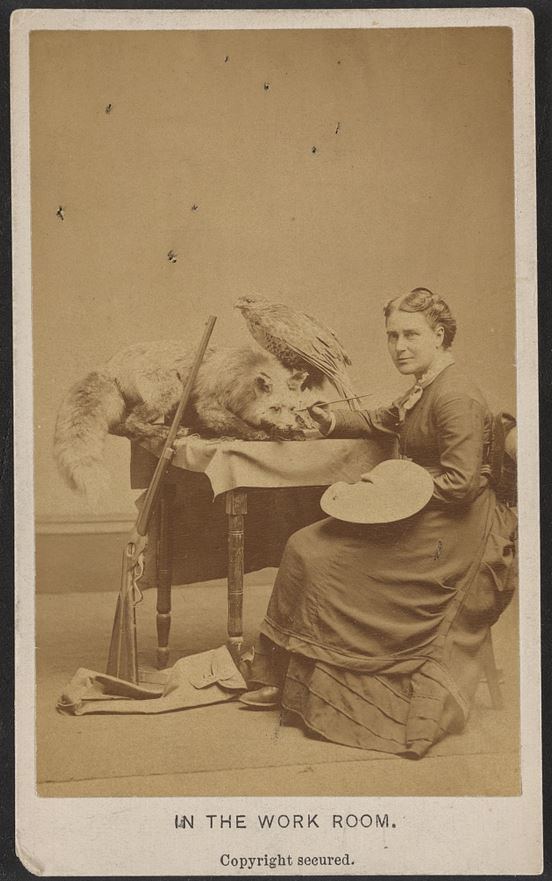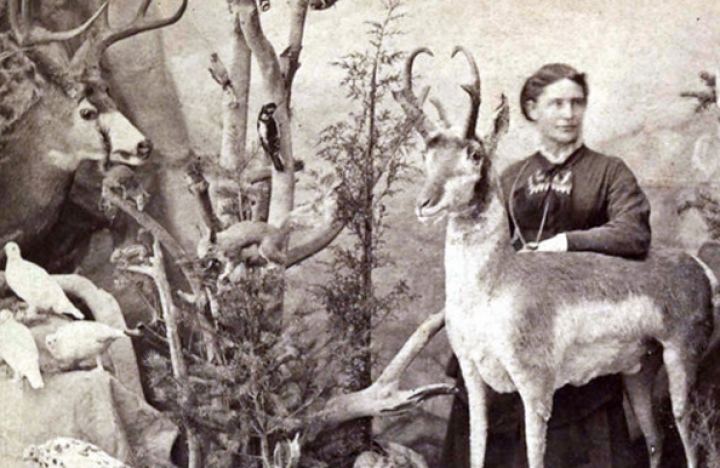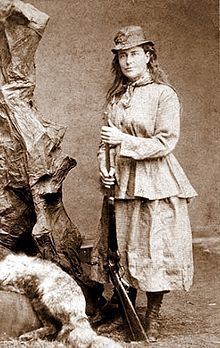Name Martha Maxwell | ||
Died 1881, Massachusetts, United States Similar People Francis Galton, Hermann von Helmholtz, Wilhelm Eduard Weber, Thomas Young, J J Thomson | ||
Martha maxwell visits the national cowboy western heritage museum
Martha Ann Maxwell (née Dartt 21 July 1831 – 31 May 1881) was an American naturalist, artist and taxidermist. She helped found modern taxidermy. Maxwell's pioneering diorama displays are said to have influenced major figures in taxidermy history who entered the field later, such as William Temple Hornaday and Carl Akeley (the father of modern taxidermy). She was born in Pennsylvania in 1831.
Contents
- Martha maxwell visits the national cowboy western heritage museum
- Early life
- Marriage and children
- Interest in taxidermy
- Career in taxidermy
- Developed taxidermy techniques
- Philadelphia Exposition
- Financial struggles
- Death and afterward
- References

Early life

Maxwell was born Martha Dartt to Spencer & Amy Sanford Dartt on 21 July 1831 in Tioga County, Pennsylvania. Her father died in 1833 and her mother remarried in 1841 to Josiah Dartt, Spencer's first cousin. It was her grandmother, Abigail Stanford, who first instilled a love of nature in Maxwell, taking her for walks in the woods. In 1851 Maxwell left for Oberlin College in Ohio with plans to become a teacher. She had to drop out in 1852 due to her family being unable to afford the tuition. She returned to her parents, who were then living in Baraboo, Wisconsin.
Marriage and children

Maxwell was teaching at a local school when James Maxwell, a Baraboo businessman, hired her in 1853 to chaperone two of his children at Lawrence College in Wisconsin. In return for her services, he agreed to cover her tuition. She had been there less than a year when James proposed to her. Despite him being twenty years older, with six children, Maxwell agreed. They were married in 1854 and had a daughter, Mabel, in 1857.
Interest in taxidermy

The Maxwell family was hit with financial ruin in the panic of 1857. As a result of this, Maxwell and James joined the Colorado Gold Rush of 1860. They left their daughter Mabel behind in the care of her maternal grandparents. The Maxwells eventually settling in Nevadaville, Colorado. While James pursued mining, Maxwell took in washing, mending and baked pies to earn her own income. She made her own investments, and bought an interest in a boarding house, some mining claims, and she purchased a one-room log cabin on the plains east of Denver.

In 1861 the boarding house burned down, leaving Maxwell with no way to earn an income and the family no place to live. The plan was to move to the cabin that Maxwell had bought but when they got there, they found that a claim jumper had moved into the cabin. They took the squatter to court, and the decision came down in favor of the Maxwells but the German man living in their cabin refused to move out. Maxwell waited until the man finally left the cabin on an errand. She removed the door from the frame and she entered the cabin and found amongst the mans possessions perfectly preserved stuffed birds and animals. The claim jumper was a taxidermist by training. Maxwell proceeded to put everything out on the prairie and reclaim her property. Maxwell soon wrote to family members requesting a book that would help her “to learn how to preserve birds & other animal curiosities in this country.”

In 1862 Maxwell returned to Baraboo, where she studied taxidermy, taught by a local man named Ogden. In 1868 James persuaded her to return to Colorado.
Career in taxidermy
Upon Maxwell's return to Colorado she began building a collection of native birds and mammals. She made trips into the Rockies where she gathered chipmunks, various species of squirrels and birds. By the fall of 1868 Martha had prepared almost 100 specimens, ranging from chicks to hawks, and hummingbirds to eagles. She was asked to display her work at the Colorado Agricultural Society exhibition. Attendees particularly admired that Maxwell created an entire natural habitat for each species, making it appear as if they were still alive. Her work was acknowledged with a $50 prize and a diploma.
In mid-1874, she opened her Rocky Mountain Museum in Boulder, Colorado to display her specimens for both education and entertainment. Hoping to find more support in a larger city, Maxwell moved her museum to Denver a little more than a year later. However she was unable to make the venture profitable. Altogether she collected many birds and mammals including black footed ferrets which had been described by John James Audubon but never seen by scientists, and the Otus asio maxwelliae (the Maxwell Owl) named in her honor by ornithologist Robert Ridgway of the Smithsonian Institution. By then she was also a regular correspondent of Spencer Fullerton Baird. Maxwell sent him two bird specimens in 1874 and he in turn supplied her with catalogs of birds and mammals.
Developed taxidermy techniques
Maxwell developed her own way of preserving the animals by molding them in plaster and then covering these molds with the animals skin which she had preserved. She later used iron frames over which to stretch the skins, rather than sewing the skins together and stuffing them, as most other taxidermists did. She also insisted that replica backgrounds portraying the animals' natural habitat were used.
Philadelphia Exposition
In 1876 Maxwell was asked to produce an exhibit for the Philadelphia Centennial Exhibition. The Colorado commissioners agreed to pay for the packing and transportation of her specimens to and from Philadelphia and her living expenses while at the Centennial. To compensate Maxwell for her time, she would be allowed to keep the proceeds from the sale of any duplicate specimens and photographs of herself and her display. She created a complex habitat diorama that included taxidermy animals (that she had both hunted and mounted), running water, and some live prairie dogs. It is speculated this display was the first of its kind. The display was one of the most popular at the internationally attended event and was heavily covered by the press. The exhibition proved so popular that the fair’s official photographic firm, the Centennial Photographic Company, was unable to keep up with the demand for images. When Maxwell had photographic copies of their images made and began selling them, however, officials forced her to stop.
Many Centennial visitors apparently wanted a keepsake of Maxwell’s popular display. Maxwell had arranged mammals and birds from both the plains and mountain regions into a realistic natural setting. Buffalo and elk roamed across the plains while bears, mountain lions and smaller creatures were posed among the rocks, each at an elevation suggesting the altitude in which they were naturally found. Like her Colorado museum displays, Maxwell’s Centennial exhibition featured both taxidermy specimens and small live animals.
Financial struggles
In the years following the Centennial, Martha Maxwell continued to struggle financially. Other exhibitions of her specimens failed to garner much attention.
Death and afterward
Maxwell died in Massachusetts on 31 May 1881 of an ovarian tumor.
After Maxwell's death her daughter contracted with a man in Saratoga Springs, New York to exhibit and/or sell the collection. The collection was exhibited several times but was then placed into storage. Unfortunately it was not put away carefully and pieces began to disintegrate. In 1920 Maxwell's sister, Mary, tried to retrieve the collection and planned to donate work to the University of Colorado. However, the pieces had aged badly and there was nothing worth preserving.
